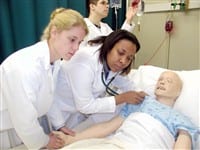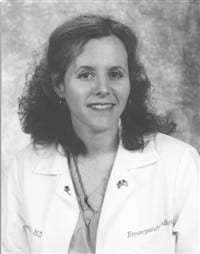Reality Show STCC’s Virtual Hospital Offers A Slice Of Life
It’s a scenario that plays itself out in a typical hospital on a weekly or even daily basis.
An elderly patient in poor health suddenly begins to deteriorate. Health care professionals, alerted to the emergency by changing vital signs, initiate a course of action. But they find themselves coping with the disparate emotions of the patient’s family members.
One daughter begs doctors and nurses to do everything in their power to save the man. But another daughter, arriving on the scene later, claims her father is a DNR, or ‘do not resuscitate’ patient. “You’re only after his money,” screams one daughter, incredulous about the actions of her sister.
It’s a typical scenario all right, but this one wasn’t played out in a hospital. Not a real one, anyway.
It took place on the third floor of the health sciences building at Springfield Technical Community College, in a facility known as the SIMS Medical Center — a Virtual Hospital @ STCC™. In this setting, the patient in question is a simulation device, a computer-controlled, high-tech mannequin that can change sexes in a minute and take on any of thousands of medical conditions. And the quarreling sisters are health science students who are becoming highly skilled role players.
The drama unfolded in the critical care unit of the medical center, which also includes an acute care area, a pediatric unit, and a surgical room. In the planning stages is an L&D, or labor and delivery unit.
It’s all part of an elaborate, entrepreneurial initiative to provide what Michael Foss, dean of the School of Health at STCC calls “total application scenarios.” In other words, he wants to create a setting that exposes students in a variety of health programs to everything — and he means everything — that they will find in an actual clinical setting.
This is real,” he said, referring to the scenario outlined above and both the patient’s condition and the reactions of family members. “This is what health care professionals face every day.”
Mary Tarbell, director of Nursing at the School of Health, said the medical center provides what she called a “pre-clinical, clinical setting.” By that, she meant that it provides another layer of preparedness for students entering health fields — one that offers an effective bridge between a textbook and an actual patient.
“I wish I had something like this 30 years ago,” she said, recalling her first practice with administering injections — which was to a real patient. “I would have preferred to work with one of these simulators first.”
The Healthcare News looks this month at STCC’s evolving virtual hospital and the opportunities it provides to both students and educators.
Student Body
Patricia Hanrahan, director of Clinical Education in STCC’s School of Health, told The Healthcare News that students working in the virtual hospital are told to make no distinction between what they see at the school’s medical center and what they encounter in an actual clinical setting.
“We don’t want to hear them say, ‘if this was a real patient, this is what I would do,’” she explained. “We want them to think of these as real patients.”
And in many cases, that’s a fairly easy assignment, thanks to improving technology in the design of simulators. The more sophisticated models, especially, look and sound quite real. They have pulses, and make heart, lung, and bowel sounds. Students can draw blood from them, administer drugs, start an IV, and even perform CPR.
And the patients, as they are called, have personalities, said Tarbell, noting that they have their own tolerance level for medical procedures and can talk to those administering the care — actually, it’s an instructor, watching events via closed circuit television, who is doing the talking.
The patients and the facilities that comprise the virtual hospital are part of an elaborate initiative on the part of STCC to take its health care learning facilities to a higher plane.
Those efforts took a dramatic step forward in late 2002, when the school acquired two high-end simulators, an adult and a child, manufactured by Florida-based Medical Education Technologies Inc. (METI). The new technology brought enhanced learning experiences, said Foss, but there were limitations — the school wasn’t able to use both simulators at the same time, for example.
Using a portion of a five-year, $1.8 million Title III grant awarded to the school by U.S. Dept. of Education to strengthen its Allied Health and Nursing curricula, STCC has acquired another 10 simulators from Laerdal Inc., which specializes in making simulators for the military, and needed.support systems. And Foss has plans to build patient volume to more than 20 over the next several months.
While building the patient population, the college has also created a facility in which care is administered. A room that once housed vending machines has been transformed into the acute care unit, while several laboratory and classroom areas have been retrofitted to create a surgical suite, a trauma unit, and a basic care department that includes a pediatric unit.
Renovation work began in earnest last February, said Foss, adding that while an open house is slated for next spring, the virtual medical center will never be completed in the true sense of that word. “This will always be a work in progress.”
The Laerdal models come in various shapes, sizes, and levels of sophistication and, therefore, pricetags, said Foss, noting that high-end models cost upwards of $30,000, while others run a fraction of that price. Each model brings different learning experiences, he said, noting one ‘patient,’ called Janet (named after Janet Wanczyk, the school’s vice president of administration/CFO) comes complete with a broken leg that students can feel to pinpoint the break and X-ray.
The medical center’s various pediatric models present different challenges, said Tarbell, adding that younger patients require smaller doses of medication than adults, and there are slight variations in several procedures, including the administering of injections.
Younger patients also bring more involvement with family members, especially parents, she said, noting that such interaction is part of the total application scenario.
“Students can work with patients, but they can also process what it’s like to deal with a family,” said Hanrahan. “This is an important part of the total application scenario.”
Exercising Patients
Tarbell said the evolving mission of the virtual hospital is to replicate an actual clinical setting in every way possible.
This includes sights, sounds (which include not only patient noises but also an intercom and ringing telephones), and smells of an actual hospital. “Someone from one of the area hospitals took a tour recently and said she couldn’t believe how much this room smelled like a real hospital.”
Replicating a clinical setting — right down to the Winnie the Pooh sheets covering the simulators in the pediatric unit — is an integral part of the process of creating total application scenarios, she said, adding that the various units of the virtual hospital provide near- real-world working environments for several health programs, including nursing, respiratory therapy, occupational therapy, radiology, surgical technology, and even dental assisting.
Using the ‘patient’ with the broken leg in the trauma unit as an example, Tarbell said students in many disciplines would gain practical experience in the process of evaluating and treating the case in question.
The same is true in the surgical suite, an area where every step in the process — from preparation of the patient to the sterilization of the instruments to be used — except the actual surgery can be practiced.
And even the surgical procedure is something that might someday be simulated, said Foss, who told The Healthcare News that he plans to approach some retired area surgeons and ask them to work with students in the surgical suite to replicate an actual operation.
While the scenarios that play themselves out in the virtual hospital are intended to be real, they are also learning experiences, said Hanrahan, noting that episodes can be slowed down, in some respects, and replayed so that students can absorb what’s happening and learn quickly from mistakes.
“We want students to be able to process what’s going on around them and figure it all out,” she said, adding that this type of learning experience doesn’t exist in the actual clinical setting.
Tarbell agreed. “We’re not replacing the clinical aspect of their learning experience — we’re augmenting it,” she said. “They’re going to be able to do things here that they couldn’t do in a clinical setting.”
Looking at the big picture, Foss said the medical center will become a regional resource, a facility that could be utilized by other area colleges and health care providers to enhance learning experiences for those entering the field and those already in it.
“STCC is in a unique position,” he said. “We have an opportunity here that I would consider very rare. We have the money, the support from the college, and the room to build a complete hospital. We intend to make the most of that opportunity.”
A Cut Above
As she talked about the capabilities of the latest patient simulators, Tarbell joked that she would like to see one that could reach up and try to knock the syringe out of the nurse’s hands as she attempted to administer an injection. “That’s when I’d think they were almost real,” she said.
To which, Foss replied almost matter-of-factly, “we’re working on it.”
If and when that day comes, it will only add another layer of realism to what is already a heavy dose of life in an actual hospital.



Comments are closed.